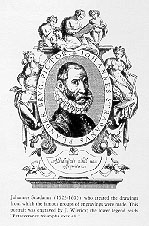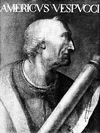In the anti-imperialistic and
gender-sensitive
critical climate of the 1990s, the unfamiliar America
(c. 1575-1580) by Johannes Stradanus (Jan Van der Straet) is making
fair
bid to replace more familiar images of our founding moment such as John
Vanderlyn's Landing
of Columbus (1844) as the heraldic shield for America, as the
emblem
of Discovery. Stradanus depicts a very European Americus Vespucci
awakening
and bestowing his name on a very naked Sleeping Beauty of a Native
American.
"Americus rediscovers America," the motto reads, "He called her but
once
and thenceforth she was always awake." Europe, Africa, and Asia had
always
been gendered female, but the image of a naked continent is
virtually
unique to America (le
Corbelier), flourishing in the last quarter of the 16th
century and persisting well into the 19th (Honour 91). This
erotic image of the first contact of European Self and American Other
is
art as "the instrument of empire," indicative that America was "produced
for Europe" (Hulme, Colonial 3,2) as a passive vulnerable
female
waiting for her lover/conqueror.
Stradanus was born in Bruges in 1523,
progressed
in 1545 to master artist in Antwerp--then "the largest and most active
port city in Europe" and the publication site of some of the earliest
travel
books (le Corbelier 210)--after which he worked in Florence producing, before his death in 1605, a spectrum of religious art for wealthy
patrons
like Cosimo de Medici, as well as collaborating with the Galle family
of
engravers in Antwerp to produce two successful series of prints (not
under
consideration here is Venationes [Hunting Scenes],
1578)--sold
as wall decorations and then bound into books--aimed at middle-class
audiences
(Dibner 3). America opens a twenty-part series of realistic
prints
called Nova
Reperta
(New Discoveries), published in the early 1580s, celebrating
Renaissance
progress in art, science, and technology, to which were appended four
allegorical
works on explorations by Columbus and Magellan as well as Vespucci
under
the title of Americae
Retectio (America Rediscovered).
before his death in 1605, a spectrum of religious art for wealthy
patrons
like Cosimo de Medici, as well as collaborating with the Galle family
of
engravers in Antwerp to produce two successful series of prints (not
under
consideration here is Venationes [Hunting Scenes],
1578)--sold
as wall decorations and then bound into books--aimed at middle-class
audiences
(Dibner 3). America opens a twenty-part series of realistic
prints
called Nova
Reperta
(New Discoveries), published in the early 1580s, celebrating
Renaissance
progress in art, science, and technology, to which were appended four
allegorical
works on explorations by Columbus and Magellan as well as Vespucci
under
the title of Americae
Retectio (America Rediscovered).
The setting in which America appears
contributes
to our understanding of its purpose and significance. Nova
Reperta
is not just a paean to progress in the European standard of
living
because of the discovery of the magnet and the cure for syphilis; or
the
invention of gunpowder, iron clocks, stirrups, the watermill, the
winged
mill, spectacles, the astrolabe, and oil paints; or the development of
processes for breeding silkworms, distilling medicines, making olive
oil,
measuring longitude, and polishing armor. More to the point, Nova
Reperta is a textbook of sorts, designed with educative purpose for
wide distribution. "The picture that you see," one motto reads,
"will
teach you in very many ways the art in which sugar
is made." And, furthermore, Nova Reperta is a series of
windows
into workshops, studies, studios, laboratories, throne rooms, city
streets,
and mill and farm yards through which common people can view a variety
of common people busy making, using, or enjoying Progress. Nova
Reperta, then, itself mass-produced through new methods of
printing
and engraving copper, is engaged in shaping the "vision" of a mass
audience.
And that didactic appeal to a wide audience
is
precisely what makes the ideology of America so interesting, so
heinous to a variety of modern critics. This is our inaugural naming
moment
seen through the naked "discourse
of colonialism" (Hulme, Colonial 8), an example of "writing
that conquers" (Certeau xxv). It reminds us that mind-management
necessarily
complements military and economic power in the repertoire of
imperialism.
Moreover, America "draws on a long tradition of male travel as
an
erotics of ravishment" (McClintock 22), is a "projection into the
New World of European representations of gender--and of sexual conduct"
(Montrose, "Work" 178), an example of a "coherent hermeneutical
strategy
of feminization and eroticization" that makes "gendered
difference"
the meaning of the New World (Zamora 157). European consciousness is
encoded
as masculine; Vespucci discovers an uncovered woman;
America
is a male "voyeur's paradise" (Mason 171); territorial conquest is
possession
of the female body; and rape--a rape invited by the irresistible
combination
of voluptuousness and vulnerability--inevitably follows gaze. What is
the
meaning of the "persistent gendering" of imperial discovery (McClintock
24)? Gender is a primary way of portraying "relationships
of
power" (Scott 42). Woman has no name, no identity, no history of
any real value till Man the Master arrives and gives her life--for his
purpose and his possession.
Stradanus first invites our imperial male
gaze
(Mulvey) to the contrast between Americus and America in the center
foreground
of his work.
Americus, fully clothed, stands straight and firm, aligned with and
between
a tree and his staff, while America, her body totally open to his gaze
if not to ours, half-rises from a supine position with an ambiguous
gesture.
Americus's strength is aggressively technological--an ocean-going ship
with sails at full-furl, the astrolabe and the Southern
Cross as signs of world-wide mobility, the sharp steel of the draped
dagger and sword; America's technology is her hammock, and, though her
body is substantial, her feathered crown and loins offer no protection
from European violence or violation, and her hand-carved club rests,
out
of reach, on a tree bearing a sloth. Man-made ships frame Americus;
pineapple
plants, an ant-eater, a tapir, and (presumably) a mountain lion frame
Nature-dwelling
America. He leaves home under the power of the Cross; she stays home
under
a bower of leaves. Europe/America, Man/Woman, active/passive,
strength/weakness,
energy/torpor, technology/nature, mind/body--this primal moment is
represented
as radical dichotomy, as radical difference.
There is one other very important element of
difference
to note, for Americus and America frame a cannibal meal in the center
background.
America, then, is a cannibal, and cannibalism
is "the mark of unregenerate savagery" (Hulme, Colonial 3),
and,
more than that, since there are no Native men depicted, America is
probably
also an Amazon,
and Amazonianism contradicts European patriarchy. Stradanus depicts not
only the land as woman but a land of women, an anticulture that kills
male
children and precisely inverts "norms of political authority, sexual
license,
marriage and child-rearing practices, and inheritance rules" (Montrose,
"Work" 201-2). America as "simultaneously naked and passive and
riotously violent and cannibalistic" (McClintock 27)--the combination
more
than justifies European intervention to restore phallocentric order
(Mason
173). America's monstrous nature demands male mastery. The
saboteur of the European way of life, the provocateur of male
anxiety
(McClintock 26-27), must be destroyed. The desire to fornicate meshes
with
the duty to subjugate. America will be woo'd and subdued with the
sword. Unlucky America.
 Vespucci's
own "prurient gaze" (Mason 171) provided a basis for the
imperial/sexual
politics of Stradanus's America. His letters from the New World
highlighted the "inordinate" lust of Native women who used the bites of
poisonous animals to thicken their "husbands' members" and were "very
desirous
to copulate with us Christians," as well as the treachery of cannibal
women who clubbed and roasted a sailor "before our eyes" (Vespucci
49, 64, 88). Though, then, Nova Reperta leaves a "clear
representation
of the crafts and technology. . . . of one of the greatest epochs in
human
history" (Dibner 2), in America it also reveals the root
ideology
that denied "the natural right of possession to indigenous peoples"
(Montrose,
"Work" 184) and resulted, some say, in one of the greatest depredations
in human history (Stannard).
Vespucci's
own "prurient gaze" (Mason 171) provided a basis for the
imperial/sexual
politics of Stradanus's America. His letters from the New World
highlighted the "inordinate" lust of Native women who used the bites of
poisonous animals to thicken their "husbands' members" and were "very
desirous
to copulate with us Christians," as well as the treachery of cannibal
women who clubbed and roasted a sailor "before our eyes" (Vespucci
49, 64, 88). Though, then, Nova Reperta leaves a "clear
representation
of the crafts and technology. . . . of one of the greatest epochs in
human
history" (Dibner 2), in America it also reveals the root
ideology
that denied "the natural right of possession to indigenous peoples"
(Montrose,
"Work" 184) and resulted, some say, in one of the greatest depredations
in human history (Stannard).
Works Consulted
Certeau, Michel de. The Writing of History. New York:
Columbia
UP, 1988
Cixous, Helene, and Catherine Clement. The Newly Born Woman.
Minneapolis: U of Minnesota P, 1986.
Dibner, Bern. "The 'New Discoveries' of Stradanus." New
Discoveries:
The Sciences, Inventions and Discoveries of the Middle Ages and the
Renaissance
as Represented in 24 Engravings Issued in the Early 1580s. By
Johannes
Stradanus. Norwalk: Burndy Library, 1953. 1-4.
Forrest, Tuomi. "Maid to Order: Columbus' 'Cannibal Girl'
and
the Captivity Narrative."
Pocahontas: Icon at the Crossroads of Race and Sex.
http://xroads.virginia.edu/~CAP/POCA/POC-col.html
(30 Nov. 1997).
Honour, Hugh. The New Golden Land: European Images of
America
from the Discoveries to the Present Time. New York : Pantheon
Books,
1975.
Hulme, Peter. Colonial Encounters: Europe and the Native
Caribbean,
1492-1797. New York : Methuen, 1986.
---. "Polytropic Man: Tropes of Sexuality and Mobility in
Early
Colonial Discourse." Europe and Its Others. Ed.
Francis
Barker et al. Colchester: U of Essex, 1985. 17-32.
Kolodny, Annette. The Lay of the Land: Metaphor
as
Experience and History in American Life and Letters. Chapel
Hill:
U of North Carolina P, 1975.
Le Corbelier, Clare. "Miss America and Her Sisters:
Personifications
of the Four Parts of the World." Metropolitan Museum of Art Bulletin
19.8 (1961): 209-23.
Mason, Peter. Deconstructing America: Representations of
the Other.
London: Routledge, 1990.
McClintock, Anne. Imperial Leather: Race, Gender and
Sexuality
in the Colonial Contest. New York: Routledge, 1995.
Montrose, Louis. "'Shaping Fantasies': Figurations of
Gender
and Power in Elizabethan Culture." Representations 1.2
(1983):
61-94.
---. "The Work of Gender in the Discourse of Discovery." New
World
Encounters. Ed. Stephen Greenblatt. Berkeley: U of California P,
1993.
197-217.
Mulvey, Laura. "Visual Pleasure and Narrative Cinema." Feminism
and Film Theory. Ed: Constance Penley. New York:
Routledge,
1988. 57-79.
Parker, Patricia. Literary Fat Ladies: Rhetoric, Gender,
Property.
Methuen: New York, 1987.
Quintana, Jorge. "Points of View: The Art of Encounter." View
from the Shore : American Indian Perspectives on the
Quincentenary.
Ed. José Barreiro. Ithaca: Cornell UP, 1990. 88-92.
Rutgers, K. M. "Stradanus, Joannes." The Dictionary of Art.
Vol. 29. Ed. Jane Turner. New York: Grove's Dictionaries, 1996. 740-42.
Scott, Joan Wallach. Gender and the Politics of
History.
New York: Columbia UP, 1988.
Stannard, David E. American Holocaust: Columbus and
the
Conquest of the New World. New York: Oxford UP, 1992.
Stradanus, Johannes. New Discoveries: The Sciences,
Inventions
and Discoveries of the Middle Ages and the Renaissance as Represented
in
24 Engravings Issued in the Early 1580s. Norwalk: Burndy Library,
1953.
Vespucci, Amerigo. Letters from a New World: Amerigo
Vespucci's
Discovery of America. Ed. Luciano Formisano. New York: Marsilio,
1992.
Zamora, Margarita. Reading Columbus. Berkeley: U of
California
P, 1993.
